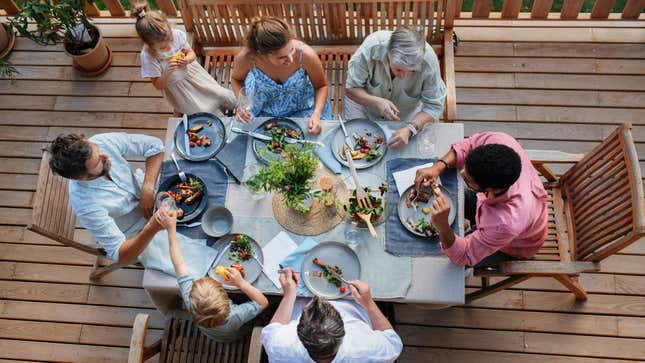
My family doesn’t vacation in destination cities with haute restaurants. We don’t go to France, Italy, Hawaii, or Vegas. Recently, my family beckoned me to the Pungo region of Virginia Beach—a lazy, cold, and quaint rural beach town far away from my home on the West Coast. Still, I was excited to take a load off. “I’m going to actually relax this time,” I told myself. That would end up being a lie, as within 48 hours I was happily bouncing around the vacation home’s kitchen preparing lunch and dinner. That’s because I have resigned to the fact that cooking, not eating out, is the best way to enjoy a family vacation.
Eating out at restaurants while on vacation is a costly activity, not to mention a high-risk venture. I shelled out nearly $1,500 on a flight, dog sitter, and transportation just to get to Virginia. Sorry, Virginia, but it’s absurd for me to fly all the way to the beaches of Pungo when I’m perpetually 45 minutes away from Malibu. Alas, I love my family. You can understand, then, why dropping even more money just to gamble on dubious restaurants in an unfamiliar town doesn’t sound too appealing.
I feel like we’re far enough removed from COVID now that we can admit a lot of restaurants suck. I know, I know—we’re all in this together, everyone is doing their best, etc. But can we at least acknowledge the existence of places that serve overpriced garbage? I’m emphasizing cost here because that’s truly the cardinal sin of dining, the unforgivable transgression that I can no longer tolerate given the current scope of livability in this country. And I’m sorry to say I had one of the most disappointing and expensive meals of my life while vacationing in Pungo.
The shrimp were mealy and underseasoned, and a good deal smaller than the 16/20’s I saw at the market for much cheaper. The clams were rubbery and bland. The “butter” was margarine. The overly breaded calamari came garnished with cheese (cheese!). For five adults and two kids, the bill soared past $300. All I thought about as I left the restaurant was what I myself could have prepared with our $300. The feast I might have provided in the comfort of our cookie-cutter beach rental would have completely outclassed this lousy crab shack.
The farms in Virginia are spectacular, providing gorgeous seasonal local produce. Spring yields May peas, fresh clams, fat shrimp, asparagus, sweet onions, cherry tomatoes, and strawberries. Some of these farms even sell baked goods; one of the best key lime pies of my life was made by an employee at BayBreeze Farms. Pungo produces marvelous food, but it doesn’t seem as though much of that food is making it to the restaurants in the area.
The day after our disappointing meal, I decided to put together a couple pasta dishes, including a cacio e pepe made from low-rent powdered black pepper and a deliciously vegan cherry tomato and garlic dish made with a heaping handful of garlic, pasta water, and olive oil. In addition to that, I made a quick iceberg lettuce salad (is anything more reliable than iceberg?). The retail price of that lunch was under $25, and it fed 8 people.
“The smell is killing me!” my little nephew excitedly remarked as I finished swirling some pasta water into the aromatic pastas. Everybody seemed more enthused about the vacation home spaghetti than the underwhelming crab shack feast. This meal’s purpose was greater than sustenance; it washed the taste of last night’s dinner out of our collective mouth.
The next day, we decided again to refrain from eating out. Instead, I spent the afternoon driving around Pungo, taking in the lush greenery, the countryside, and the blue skies full of clouds that seemed to pop more the farther I got from our beach house. In short, I was sightseeing—the sort of thing you’re supposed to do on vacation.
I returned home with a bounty: fresh Virginia oysters, Chesapeake Bay clams, perfectly seasoned boiled shrimp, scallops, corn, fingerling potatoes, crunchy greens, purple cauliflower, scallions picked from the dirt, and Ziploc bags of fresh peas kept on ice. I found that by purchasing and cooking our own meals I was not only saving valuable money but also having a more authentic vacation experience. I was appreciating the scenery, the people, and the land more than I would have from a vinyl booth in a tourist trap restaurant.
I completely understand the appeal of eating out while on vacation. It’s vacation. You’re not supposed to be doing anything, really. Still, there’s something so communal and beautiful about cooking with your family in a beach house, of all places. It’s rare to get everybody (my parents, brother, sister-in-law, kids, aunt, and uncle) under the same roof at the same time. Firing up a bunch of pots and pans with them makes for a memorable experience, the type of thing that makes me appreciate my family in the first place. People bumping into each other, standing and eating, being loud and cracking jokes. A tribe coming together to make a meal happen—that’s what I live for. And if this bonding also saves everybody a ton of money, all the better.
I derive a great deal of happiness from being thrifty. I spend when I need to, but when it comes to food, I know that in Pungo more often than not the product is better in my hands, and I’m thankful for the caring farms, food purveyors, and passionate people who provided these wonderful products. While the same isn’t true for every vacation destination, cooking a few nights is a great way to mix it up, save some cash, and break up the monotony of restaurants. Maybe next year I can convince my family to meet me an hour away in Malibu, but I won’t hold my breath.